
The tires on your motorhome or travel trailer do quite a lot of heavy lifting – literally. RV tires are responsible for carrying your home and getting you to your next adventure. Tires are the only part of your RV that have direct contact with the road. They directly affect your handling, ride, braking and safety.
RVers should check their tires on a regular basis to protect their safety and their RV. Tire inspections should be performed monthly and always before beginning their next trip. The more these inspections are performed, the easier it will be to find a small problem and fix it before it becomes an expensive and time-consuming repair.
Why RV Tire Maintenance Matters

Tires are one of the most important aspects of your RV. They must support the weight of your RV, as well as provide protection against obstacles you encounter on the road, including potholes and road debris. Around 11,000 accidents occur every year due to bad tires, according to the National Highway Traffic Safety Administration (NHTSA). Poorly maintained tires can lead to flats, blowouts or cause the tread of the tire to come off. Caring for your tires not only makes your vehicle safer to drive, but it also can help save you money.
The NHTSA reports that having properly inflated tires can save you, on average, 11 cents per gallon on fuel. A well-inflated tire helps maintain good fuel efficiency by eliminating factors that could make your vehicle use more fuel. Additionally, maintenance – such as rotation, balance and alignments – can help your tires last longer which in turn helps save you money. If properly inflated and maintained, the average life of a tire can extend by 4,700 miles.
RV Tire Maintenance Basics

Tire maintenance should be performed at least once a month. During this monthly check, RV owners should complete a visual inspection, a tread inspection and monitor your tire pressure. Below you will find a guide on what to look for while inspecting your tires.
Visual RV Tire Inspection
A visual inspection is the easiest check when it comes to tire maintenance, but you need to know exactly what to look for to ensure your tires are in good condition. Here are the list of things to keep in mind:
- Cracks and Missing Chunks – Years of constant use and exposure cause the rubber compounds within the tire to age, leading to cracks and missing fragments.
- Scrapes, Punctures and Cuts – Check your tread and sidewalls for anything out of the ordinary. If you see anything suspicious, have a General RV technician take a closer look.
- Tire Bubbles – Bubbles can form in your tire after any type of severe damage – such as a run-in with road debris, hard impacts with a curb or even driving on a flat tire. Check for bubble-like bulges on the sidewall or in the tread.
- Over-inflation – Too much air pressure means the tire’s middle section will be mostly in contact with the road. This can cause the center of the tire tread to wear out before the tire’s edges.
- Under-inflation – Too little air pressure can cause the reverse problem, placing the majority of road contact on the tire’s edges and causing less wear in the center.
RV Tire Tread Inspection
Tire tread is vital to ensuring a safe and easy ride. Tread provides the traction that prevents your RV from slipping and sliding, especially when the road is wet or icy. Tread also makes sure your motorhome, travel trailer or tow vehicle accelerates smoothly and brakes quickly.
Tires are not safe and should be replaced when the tread is worn down to 2/32 of an inch. Many tires have tread-wear indicators, also known as wear bars, to let you know when it is time to replace them. You can also check your tread using the quarter or penny test.
Place a quarter into a tread groove with the top of George Washington’s head facing down. If the top of his head is not visible, your tires have at least 4/32 of an inch of tread and are fine for continued use. If you can see the top of Washington’s head, it is time to start shopping for new tires. You can do the same test with a penny. If you can see the top of Abraham Lincoln’s head, it means your tires have less than 2/32 of an inch of tread and need to replace your tires immediately.
During the tire tread inspection, you should also look for any signs of uneven wear. Irregular tire wear is an indication that there may be a problem that needs to be fixed. Different uneven tire wear patterns are usually caused by improper alignment, over inflation, under inflation or a worn-out suspension.
RV Tire Pressure
Good tire pressure is vital to ensuring optimum performance and mileage. RV owners should check their tire pressure at least once a month. For the most accurate readings, you should check early in the morning before you drive your motorhome, travel trailer or tow vehicle so that the tires are cool. Checking your tire pressure only takes a couple minutes. Here is how to do it:
- Ensure your tires are cool. Measurements should be taken before you’ve driven your RV or at least three hours after driving
- Remove the valve cap on your tire
- Press your tire pressure gauge onto the valve stem and read the pressure
- Repeat for all your tires – including the spare – and note down their pressures
- Ensure all pressures are within the recommended inflation pressures. The number can be found in your RV owner’s manual or on the tire information decal attached to the driver’s door jamb
The Right Tools for Your RV Tires
There are countless accessories and parts you can buy for your motorhome, fifth wheel or travel trailer – but when it comes to tires there are some essentials you should have on hand in case of emergency. Having these accessories will help protect your RV so it looks and works great for miles and miles to come.
Tire Pressure Gauges
A tire pressure gauge is essential for every RV. They are necessary to accurately test your tire pressure. Whether you prefer analog or digital gauges – General RV has you covered.
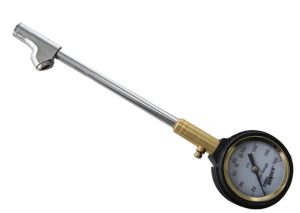
TireMinder’s Compact Dial Tire Gauge is one of the most accurate and affordable tools on the market. The compact and lightweight version includes an analog, easy-to-read dial. It also comes with a carrying case for simple storage.
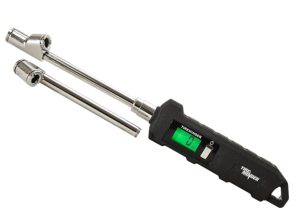
If you prefer something with a digital display, try TireMinder’s High Precision RV Gauge. The all-metal tool offers an incredibly accurate 1 PSI precision level. It comes with AAA batteries, two interchangeable heads and a bright LED backlight. It also comes with a custom “no sweat” grip and a front-facing flashlight.
Tire Valve Extenders
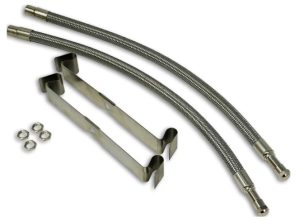
When your tire valves are just too hard to reach, turn to TireMinder’s Valve Extenders to lend a hand. Made with braided steel, they easily screw onto your tire valves and make your life easier when checking your tire pressure or inflating your tires. Valve extenders come in a variety of sizes to suit your RV.
RV Tire Air Compressor
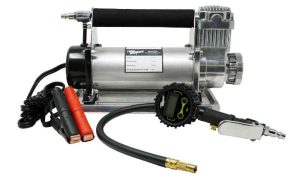
By keeping an air compressor in your RV, you no longer need to stop at a dedicated shop to top off your tires. The TireMinder RV Air Compressor features an extremely high airflow rate, while maintaining a quiet sound rating (less than 60 decibels – about as loud as a normal conversation). At only 14 pounds, this tool can fill a Class A tire from flat to 100 PSI in less than 12 minutes. Topping off can be finished in seconds. This air compressor is specifically designed for RVs to allow you to accurately and quickly fill up your tires.
Tire Pressure Monitoring System
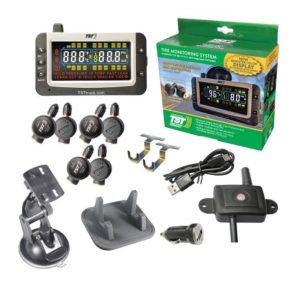
If you want to have the most up-to-date information about your RV’s tire pressure, then you should think about installing a tire pressure monitoring system (TPMS). Truck System Technologies’ Flow Thru Sensor TPMS provides a real-time display of pressure and temperature. The monitor gives visual, audible and textual alerts when conditions are at unsafe levels. This system is designed to accommodate all sizes of tow vehicles, fifth wheels, travel trailers and motorhomes. Wireless cap-style sensors are light, compact and water-resistant for use in all climates and weather. The system is easy and quick to install on any RV.
Other RV Tire Maintenance

In addition to the monthly maintenance measures any RVer can do before their adventure, there are other procedures that RV technicians and professionals should do because they require special tools and knowledge.
Tire Rotation
Tires on the front and rear of the vehicles operate at different loads and perform different steering and braking functions. This can cause unequal wear patterns. To ensure you gain maximum life and performance it is essential to rotate your tires. Most RV manufacturer’s recommend tire rotation between 3,000 and 8,000 miles. Whether you are driving a Class A or towing a travel trailer behind your pickup truck – refer to your owner’s manual for recommended mileage.
Wheel Alignment
If you notice any uneven or irregular tread wear on your RV, your vehicle may be in need of alignment. Wheel alignment is the measurement of the position of the wheels compared to the specifications that the RV manufacturers recommend. Each vehicle has specific wheel alignment settings. You should have the wheel alignment checked and adjusted when new tires are installed.
If you are driving at a steady speed and feel like your RV is pulling to one side, it may indicate a problem with your wheel alignment. If you notice this change, contact General RV Center and schedule your service appointment as soon as possible.
Contact General RV Center for your RV Tire Questions

Have a question about your tires? Let General RV help answer it. Our highly trained technicians can help with all of your RV service needs. Our team works on a huge selection of motorhomes, travel trailers and fifth wheels. Need RV parts? We’ve got those, too. Visit a General RV Supercenter near you for any maintenance concerns so we can get you back on the road as soon as possible.